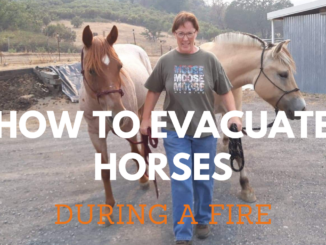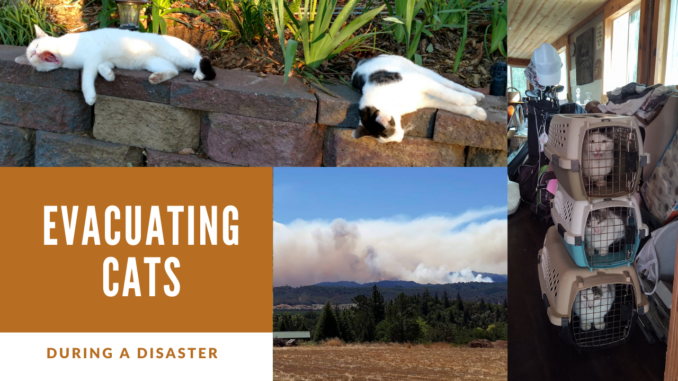
It’s fire season and you may need to evacuate! Are you ready? Learn about preparing for a disaster, planning and equipment needed, and safely relocating with cats. You will also learn how cat personalities affect their response to a stressful situation, and how to best handle them.
Evacuating cats during a disaster
If you had to evacuate today, would you know what to do? Are you prepared? How would you get yourself and your cats to safety? Read on for some critical information on evacuating quickly and safely.
Living in California all my life, I have experienced the horror of wildfires, especially in recent years. From 2017 to 2020, California has experienced 33,000 wildfires which burned 5 million acres of land and killed nearly 200 people. That’s just in California – turn on the news any times to see fires in Colorado, Arizona, Idaho, and even Oregon and Washington. Where you live, you may experience other natural disasters like floods, hurricanes, and tornadoes, all requiring you to leave your home and get yourself and your animals to safety.
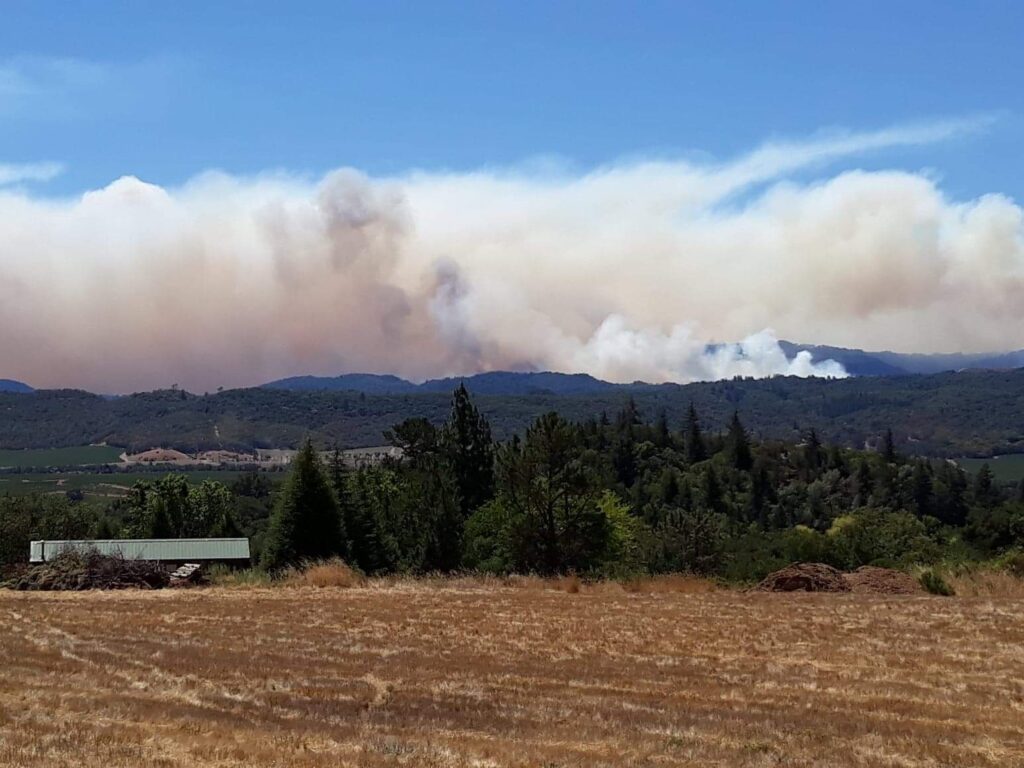
I’d like to give a shout out to all the first responders who risk their lives for us. One of the ways we can honor them is to keep ourselves safe and follow evacuation orders immediately. When we delay or refuse to evacuate we put ourselves, our animals, and the first responders at risk.
Cat personalities
Understanding your cat’s personality will help you more effectively handle him or her during a stressful situation. We can generalize about some cat behavior; for example, most cats don’t travel well, don’t like change, and don’t like getting in the carrier. Some cats are outgoing and want to be everyone’s friend, while others are skittish and will hide even from their owners. You will have to make different decisions as you prepare to evacuate depending on each cat’s personality.

A friendly, easy going cat may be easy to pick up and put in a carrier. A cat who is harness trained and goes on walks may be less stressed out by travel and a new environment. It is important to note, however, that even the most friendly cat may become skittish and even appear feral when under extreme stress or in a strange environment, so assume nothing and give yourself plenty of time to do what you need to do.
Preparation
No one wants to deal with a disaster, but it will be worse if you wait till the last minute. Even a little preparation will make evacuation day go much more smoothly. One of the most important things you can do at any time is to condition your cat to go in the carrier. You can do this by leaving a carrier out with the door open, propped or tied open so it won’t close. Put food, treats, or toys inside and just leave it there. Let them get used to seeing it and going into it. If they go in, don’t close the door! In fact, don’t do anything. Let them go in and out as they please until it becomes a non issue.
If your cats have outdoor access, it’s a good idea to bring them in if there is a chance of evacuating in the near future. Cats tend to hide when they sense change or stress – just ask anyone in the process of moving – and you don’t want to waste valuable time while trying to evacuate or worse, have to leave them behind. If your cats are indoors but you have a big house with lots of hiding places, bring them into one room or a smaller area where they can be easily gathered up in an emergency.
Identification
All cats should be microchipped, and the chip should be registered. If you don’t know if your cat is chipped, you can have him or her scanned at the vet. If s/he is not chipped, call your vet TODAY to schedule this! Cost is minimal and it’s lifetime protection should your cat go missing. A microchip is not a visible ID, but if a finder takes the cat to a vet or shelter, they will be scanned and you will be contacted. Some rescue groups and volunteer missing pet teams have their own scanners so can do this remotely as well.
I don’t personally recommend that cats wear collars. I have seen too many accidents, even with stretchy or breakaway collars, including infection around the neck, getting a paw or leg stuck under the collar causing injury and infection, and even death by strangulation. That said, if your cat wears a collar, that collar should include ID. If you don’t like the dangly tags, there are options to have your info embroidered on the collar or attached with a sleeve that is flush with the collar.
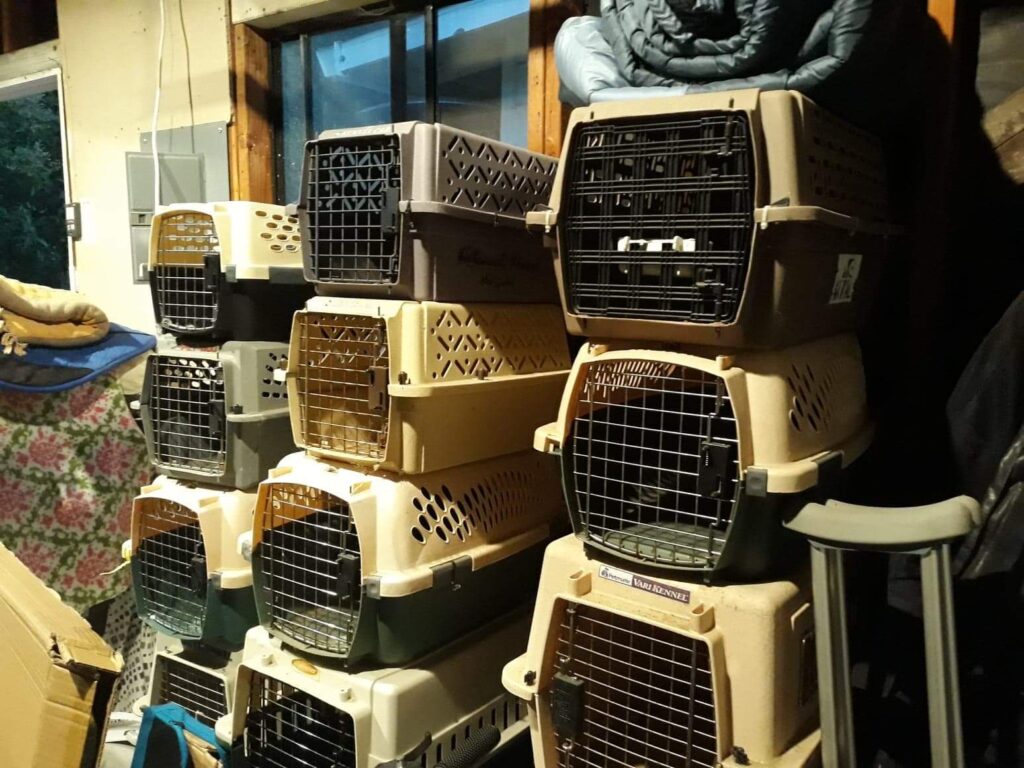
Write your name and phone number on your cat carriers with a sharpie. That way, even if the cats don’t have individual ID, they are connected to you while in transport.
Supplies
When disaster hits, people go crazy and crowd stores and gas stations. When the evacuation orders were recently issued in my area due to the Wallbridge wildfire (NorCal), every gas station in town had a line down the street. For this reason, you want to be stocked up ahead of time. It never hurts to have a stash of bottled water, granola bars, and other long-lasting essentials for yourself as well as an excess of pet food, meds, and anything else you need for them on a daily basis.
If you have a lot of cats like me, you probably buy food in bulk. You may not be able to take a huge storage bin with you in an evacuation, so keep a smaller bag on hand for that purpose, or use a small storage bin like the kind for cereal or leftovers. This will keep food fresh and easy to pack. If your cat is on a special diet like raw or cooked foods, not processed, you may not be able to continue with this diet in an emergency situation. Getting your cat accustomed to a kibble product that is easy to find will be helpful, even if you prefer not to feed such foods on a regular basis.
Grab a litter pan or something you can use as a litter pan and your cat’s regular litter. I always have extra pans in the garage since I’m involved in rescue and someone might bring me a kitten or a cat needing a temporary foster.
It goes without saying that you will need one carrier per cat. Now is a good time to check that you have enough carriers and that they are in good repair. Keep them clean and stacked neatly in an easily accessible area, not in an offsite storage locker or under a mountain of other stuff in your garage. In an emergency, you will need to grab and go, and you won’t have time to search. If your carriers are old and coming apart, replace them. They aren’t too expensive and can be found at any pet store or on Amazon.
If you have fearful, feral, or outdoor-only cats, you may need a humane trap. Once trapped, cover the trap with a sheet or towel and use it as a carrier until you get to your destination.
Evacuation day
The day has come and it’s time to go! What should you do first? Take a deep breath.
Cats, and all other animals, pick up on your emotions. If you are panicking, running around, raising your voice, your cats will be equally freaked out. They may run from you, hide, or even scratch or bite. Remain calm, have a plan, and stick to it. Fake it till you make it. Even if you feel upset, move deliberately, speak quietly, and keep your emotions in check.
I can’t believe that I have to say never transport loose cats in a vehicle. This should be self-evident, but people do it all the time. I have handled many missing cat calls through Mission Reunite that originated in this way. In my shelter days I often had to tell adopters to not open the carrier in the car on the way home. They thought the cat should be let out to stretch its legs or because the kids wanted to pet it!
Evacuation location
You’ve safely evacuated from your home and arrived at your destination. Now what? You will likely want to let the cats out, especially if they have been in the carriers for a long time. You may have driven a long way or been stuck in traffic. Someone may have had an accident in their carrier. Despite all that, DO NOT let them out until they are in a secure area.
Upon arrival, assess the situation and find out where you will be staying. If you are at the home of a friend or relative, this will be easier, because you will likely have a bedroom or portion of the house to stay in. In this case, get the room all set up with food, water, and a litter box. Bring the carrier(s) in, set them down, and open them. Do not try to pull or dump the cats out. Let them come out when they want to. Some may bolt right out and look for a place to hide, some may venture out slowly, while others may stay frozen in the carrier for a while, perhaps until they are alone or after dark. Let them do as they want. Minimize traffic in and out of the room once the carriers are open. Lock the door if possible, or put up a sign “DO NOT ENTER – CATS.”
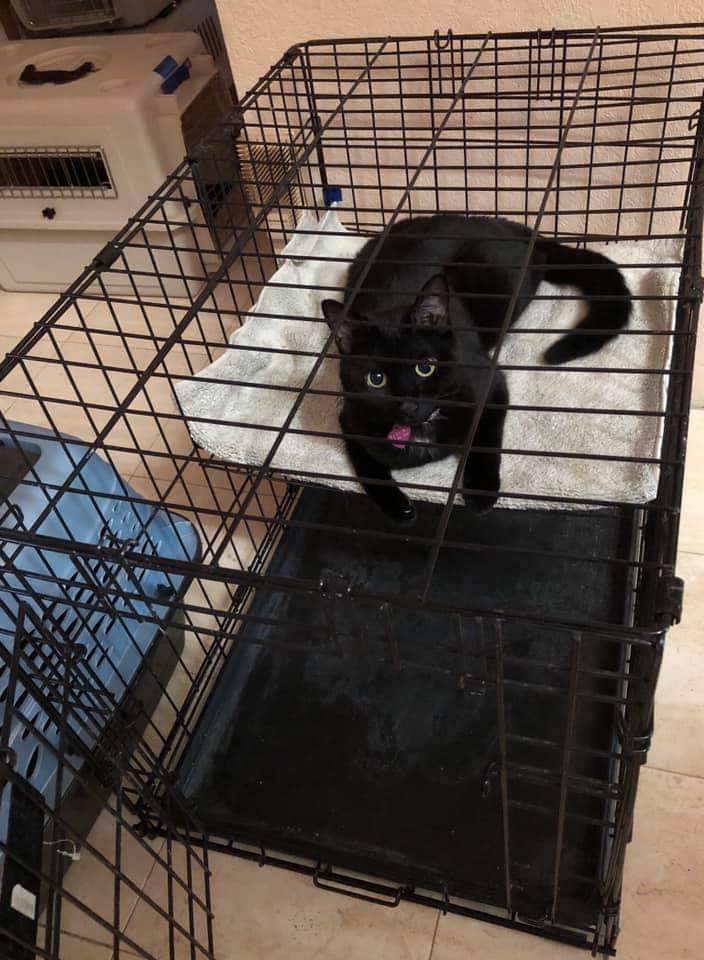
If you are going to an evacuation center, this will be more complicated. These are often located in a gymnasium, fairground, or other large open area. In 2017 I volunteered at my local fairgrounds when folks evacuated from that year’s fires. I assisted anyone with pets, making sure they had food, water, and whatever else they needed. One woman evacuated with five or six cats in carriers and didn’t know what to do. Her area was set up with a cot and blankets, but how could she let the cats out? Fortunately another resident not in the danger zone invited her to his home and gave her a room to let the cats out. Another man arrived with his cat in a carrier and wanted to know if he should let him out in the field across the street where folks were walking their dogs! I insisted he should not, and hope that he found a better solution. A last resort method is to set up a large dog crate with a litter box and let your cat(s) in there if there is not safe and secure area to let them out.
Prevent loss during transport
Many, many cats go missing during transport and in a new location! Use extreme caution, and don’t expect your cats to behave the same way they do at home. Follow all the previous instructions on ID and confinement to keep your cats safe. A lost cat in an unfamiliar area can be difficult to recover as they don’t know where they are. They may hide and not emerge or bolt in fear and end up far from where you are searching. They may be captured by a local resident and kept or taken to a shelter weeks or months later after you have stopped looking.
In conclusion
- Be prepared, especially if you are in a fire zone.
- Act quickly but don’t panic. Have a plan and follow it.
- Make sure the shelter location is safe. Don’t let your cats go missing.
- Make sure your home is safe for both you and cats before returning.


